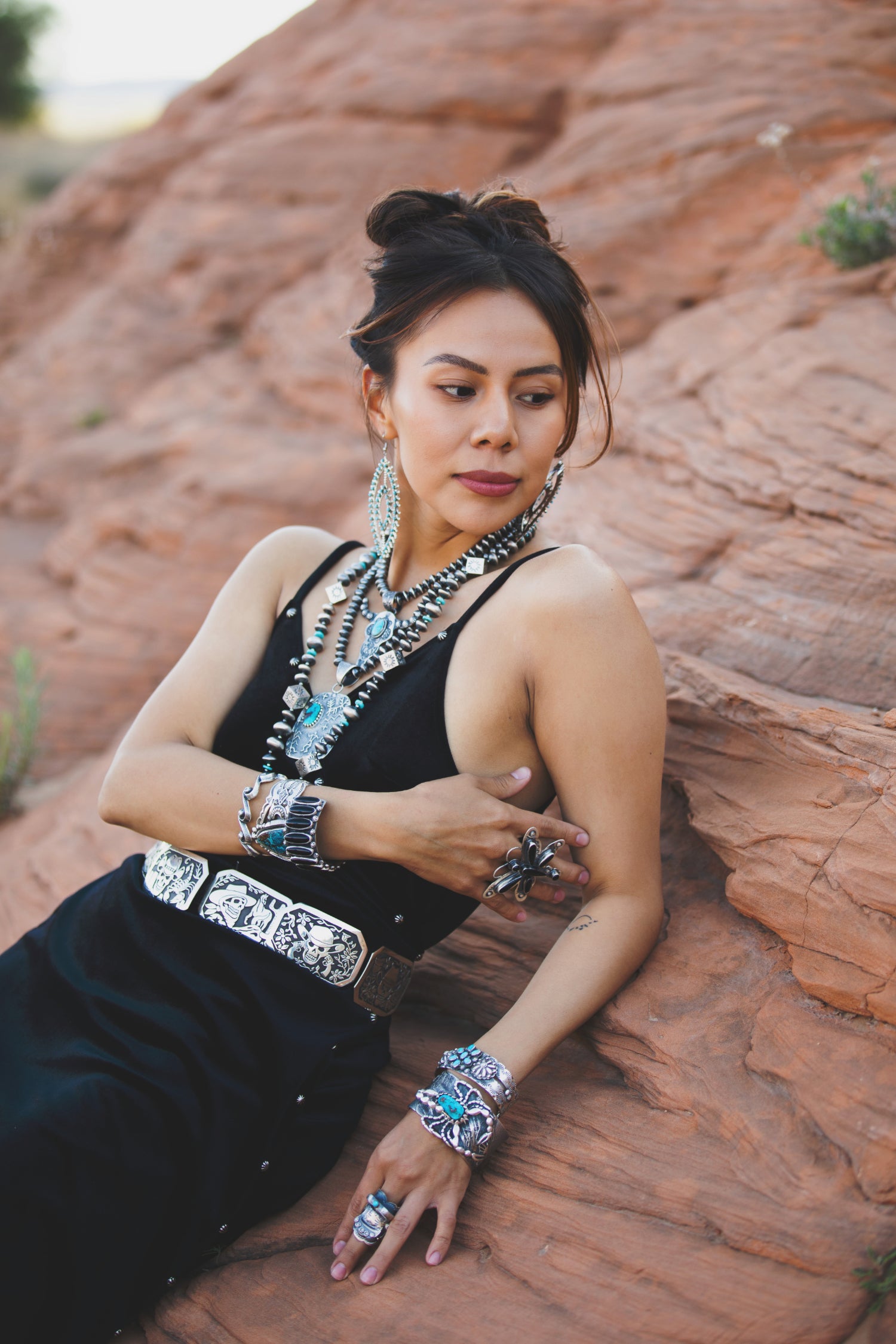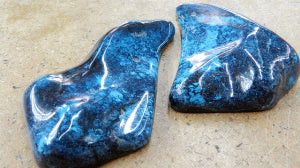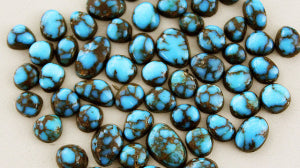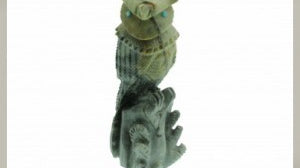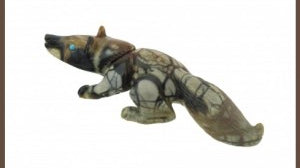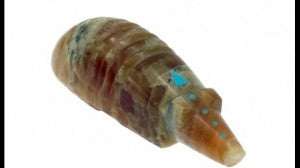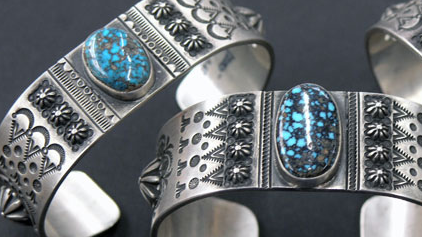Perry Null Trading
Stormy Mountain Turquoise
Stormy Mountain Turquoise Mine in Elko County, Nevada produced an extremely high quality turquoise. Found in the early 1970’s when a new road to an old copper mine was being bulldozed. For the most part Stormy Mountain turquoise is a very hard, medium to dark blue material flecked with black chert. In the best grades the veins can run up to one inch thick. Stormy Mountain Turquoise from this mine is rarely seen today.
Nevada Blue Turquoise
Nevada Blue turquoise belongs with the finest turquoise to come out of Nevada. Once known as the Pinto or Watts mine, the Nevada Blue Turquoise Mine is near the crest of the Shoshone Range in Lander County, Nevada. The deposit was discovered by Jim Watts in 1901 and later sold. Access to this mine is extremely difficult. In its high-grade form the colors range from a medium to a dark blue with a black or brown spider webbing.
Fox Turquoise
The Fox mine, once known as the Cortez, has been one of the largest producing mines in Nevada for almost a century. An official notice of location on the property under the name of "Fox Lode Mining Claim" was filed in 1914 by Charles Schmidtlein and Johnnie Francis. It had been mined in prehistoric times and had been known for years to the Indians of the area before the filed claim. The Fox turquoise mine is located in Lander County near Crescent Valley, Nevada. After going through numerous owners the mine was purchased in the 1940’s by Dowell Ward who continued the Fox’s development into Nevada’s most productive mine.
Easter Blue Turquoise
The Easter Blue turquoise mine is located northwest of Tonopah, Nevada a few miles from the Royston district. Turquoise from this claim has also been called Blue Mountain and Blue Gem. Compared to some of the other deposits in Nevada, the Easter Blue was never considered a large producer and changed hands a number of times. The deposit was discovered in 1907 by Lew Cirac who then sold it to Lee Hand in 1915. Hand leased the Easter Blue to W.R. Gilbert who produced about 100 pounds of fine turquoise from the surface. A few owners later the mine produced 300 pound a month for nearly four years. The mine was later sold to Peter King, of Manassa, Colorado and was operated once again as the Easter Blue.
Candelaria Turquoise
Orvil Jack Turquoise - Blue Ridge Mine
The Blue Ridge mine, in Lander County, Nevada, is in the rich Bullion Mining district and consists of nine mining claims. Orvil and Bessie Jack who had just moved to Nevada from Colorado filed the claim in 1956. The first turquoise to come out of the Blue Ridge was some of the finest blue spider web found in Nevada. This material is rarely seen today.
Introduction to Southwest Native American Baskets
Step into any southwest trading post and amidst the displays of dancing kachinas, Navajo rugs and turquoise jewelry your eye will soon fall upon woven baskets in subtle shades of tan, cream and brown or bright, bold colors. High and low, hanging on walls and suspended from ceilings, these beautiful art forms capture the imagination. From turn of the century Apache ollas and finely coiled Navajo wedding baskets, to contemporary Tohono O'odham trays and Hopi plaques, each basket carries the enduring echo of ceremonial songs, religious rites and tribal histories.
Owl Zuni Fetish Meaning
In Zuni culture a fetish represents the animal spirit thought to reside in the stone. It is believed that fetishes require a meal of cornmeal and ground turquoise occasionally.. Fetishes may be kept in a clay pot as it is the tradition. However, collectors usually like to keep theirs somewhere where they can be admired and enjoyed. If you add an owl to your collection you may be wondering what it represents and why it is significant. What is the Owl Zuni Fetish Meaning?
Picasso Marble - Zuni Fetish Carving
Travel around the Southwest and you will see a variety of landscapes from brilliant red mesas, to dense mountain forests to rugged deserts. It is in this rugged terrain we find this stunning marble, a common stone used in Zuni fetish carvings. Picasso marble, also called Picasso jasper, is mined in the Four Corners area in the Star and Frisco mining areas west of Milford, Utah.
Onyx - Zuni Fetishes
Onyx is a mineral like marble or granite. It is a form of chalcedony, and as such is part of the quartz group. Like the other stones in the chalcedony family, this material has a smooth, waxy luster. It can be found in a wide range of colors (white, reddish brown, brown and banded), often in contrasting layers. You often see the mineral in black and white parallel layers or in brown and white layers called sardonyx. You can see such layering in the armadillo fetish below that is carved by Abby Quam and Clayton Panteah.
Red Mountain Turquoise
The Red Mountain turquoise mine produces a very fine turquoise. Known for both the high quantity of small high-grade nuggets that it produced and the beautiful dark blue spider web of its best grades. Red Mountains top material is a hard compact spider web and is equal to any of the classic turquoise mines such as Number Eight, Lone Mountain or Nevada Blue. Besides a dark blue color with a dark matrix the mine produces colors in the blue green range with a stunning gold or rust-colored spider web.
Morenci Turquoise
Morenci turquoise was mined in Greenlee County in southeastern Arizona. Morenci turquoise is highly prized for its beautiful blue colors, which vary from a light to a very dark blue. Also for its unusual matrix of iron pyrite or "fool’s gold" that when polished often resembles silver. The turquoise was a by-product of the Morenci copper mine in Arizona. For many years heavy-equipment operators at the mine would "lunch box" the high-grade turquoise out. The March 1977 edition of the “International Turquoise Annual” states, "Many years ago, while mining for copper, workers unearthed a large zone of turquoise-bearing rock and, realizing its value, began working this zone, neglecting the copper.

